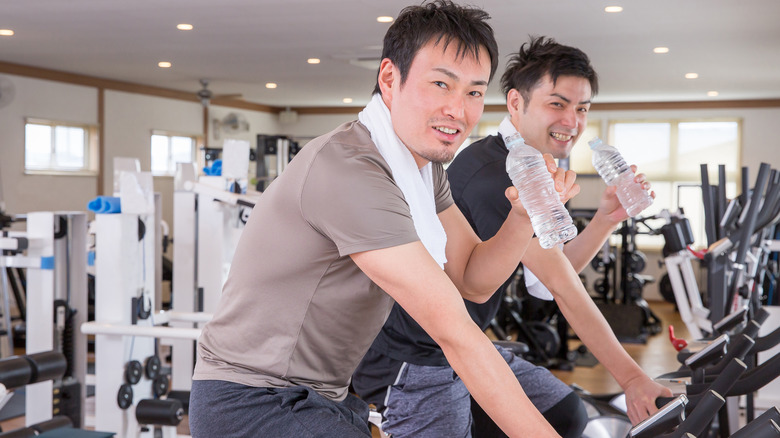How Much Water Is Safe To Drink During An Indoor Cycling Workout?
Indoor cycling is a great way to fit in a fun, low-impact workout that you can do at home or in a group class to throw socialization into the mix. In fact, indoor group cycling, also called spin or stationary cycling, has become so popular that approximately 6 million people participate each year (via Statista). Just like any other form of exercise, indoor cycling goes hand-in-hand with hydration, and knowing the right amount of water to drink before, during, and after your workout can help you perform at your best.
According to WebMD, indoor cycling is usually high-intensity, and a typical class can significantly elevate your heart rate for up to an hour. It's a workout that strengthens your glutes, legs, endurance, and muscle strength. Indoor cycling, whether participants choose a group class or a virtual session from home, is a good fitness option for beginners and those just starting to dip their toes into physical activity. Many doctors recommend indoor cycling for patients who have high blood pressure, high cholesterol, and diabetes. The exercise format can even be beneficial for people who have arthritis, though your doctor's approval should be obtained first.
Determining the appropriate amount of water to drink during an indoor spin session may feel like a Goldilocks conundrum, where too little water can cause dehydration and too much water can lead to adverse side effects. Here's how much water you should drink during an indoor cycling workout and how to create balance.
Dehydration can be dangerous
When you attend an indoor cycling class, you'll likely be instructed to bring cycling shoes or compatible footwear, a sweat towel, and a water bottle, reports Elite Daily. Of all the items you pack in your gym bag, however, your water bottle is the most important. Larger bottles are recommended over small ones since the fast-paced and high-intensity nature of indoor cycling can lead to the need for greater hydration. A suggested tip is to drink a few sips of water approximately every 10 minutes during a spin class. During an average hour-long indoor cycling class, your body can lose up to 60 ounces of sweat (per Spinning). When you sweat, your body actively loses fluids, so rehydrating is essential. One way to keep track of the fluids your body loses during workouts is to weigh yourself before and after you exercise.
If you don't drink enough water during an indoor spin session, you can become dehydrated. Not only can this thwart your performance, but your mental function can erode as well (via The University of Utah Health). A domino effect can then occur, where your decision-making capabilities, concentration, and motor control can weaken. Other symptoms of dehydration include fatigue, dizziness, dark-colored urine, and diarrhea, per Mayo Clinic. In severe cases of dehydration, organs, especially the kidneys, can become damaged. Excessive sweating is a risk factor for dehydration, and not consuming adequate water during intense exercise can lead to a dangerous heat injury.
Don't overdo it
To avoid dehydration, you may think it's best to consume as much water as possible during an indoor cycling class. However, too much water can have its own negative side effects. Drinking too much water puts you at risk of developing hyponatremia, a condition that occurs when sodium in your body's blood becomes too diluted and reaches dangerously low levels, per Cleveland Clinic. Essentially, after losing a significant amount of sodium from excessive sweating, drinking too much water can dilute the remaining sodium in your blood, leading to muscle cramps, nausea, low energy, mental confusion, and even seizures.
Keeping yourself safe from both dehydration and hyponatremia during an indoor cycling class comes down to determining the appropriate amount of water for your body. Approximately two to three hours before an indoor cycling class, try to drink 16 ounces of water to give your body a boost and keep dehydration at bay (via Spinning). To avoid hyponatremia, it's recommended that you don't drink more than 16 to 24 ounces of water per hour while indoor cycling. After a particularly intense workout, a sports drink or beverage containing electrolytes can help your body regain the essential minerals it needs to recover. In total, your hydration goal should be 40 ounces of fluids from a combination of drinking water and sports drinks before, during, and after an indoor cycling workout.


